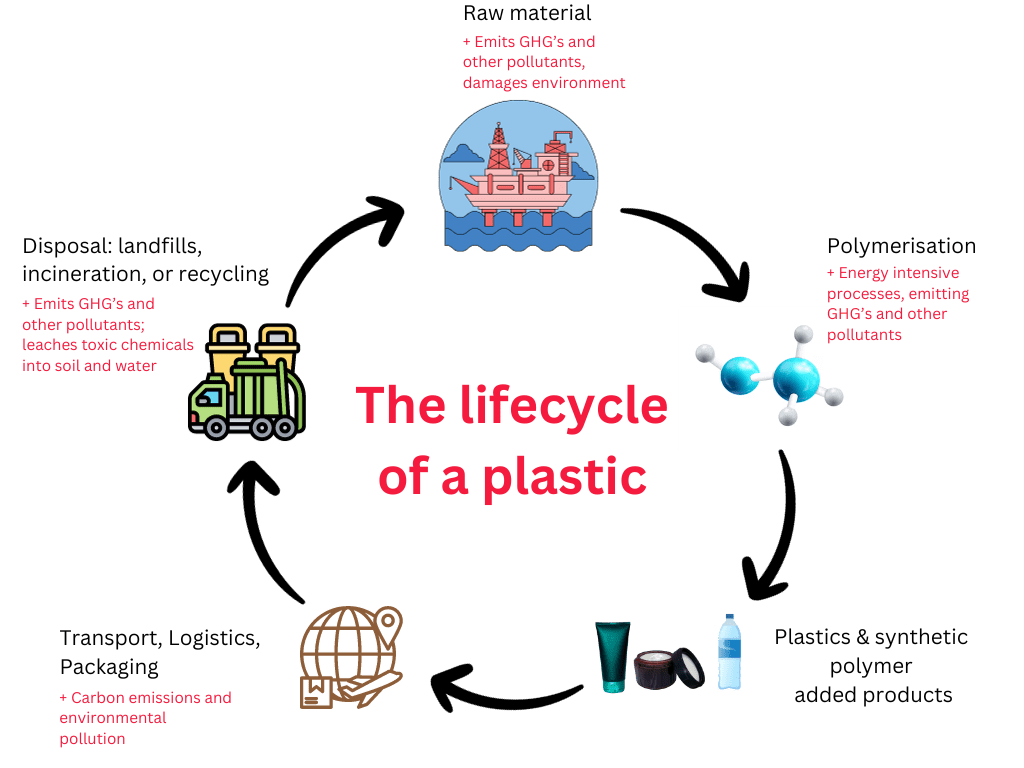In a monumental move toward environmental sustainability, the United Nations has recently announced a comprehensive ban on plastics, recognizing the urgency of addressing the escalating global plastic pollution crisis. The law, proposed on March 2, 2022, is to be finalised and brought into effect by 2024.
Why is the ban significant?
Several countries have voluntarily proposed regulations to end certain aspects of plastic pollution, e.g. the ban on added microplastics to consumer products under the REACH regulation in Europe, or the Modernisation of Cosmetics Regulation Act (MoCRA) in the US.
However, this landmark ban proposes an internationally, legally binding instrument on plastic pollution, that’d place an emphasis on a holistic approach and also address the ‘full life cycle’ of plastics versus solutions around recycling or waste treatment.
The transboundary nature of plastics and synthetic polymers
The ban acknowledges the transboundary nature of plastic pollution and emphasises the importance of a full-cycle approach and global cooperation to combat it.
In the November 2023 meeting of the third session of the Intergovernmental Negotiating Committee (INC) for the ban, The Executive Director of the UNEP, Inger Andersen shared: “The resolution passed at UNEA 5.2 (the fifth United Nations Environment Assembly in 2022) called for an instrument that is, and I quote, ‘based on a comprehensive approach that addresses the full life cycle of plastic. Not an instrument that deals with plastic pollution by recycling or waste management alone. The full life cycle. This means rethinking everything along the chain, from polymer to pollution, from product to packaging.” She added, “We need to use fewer virgin materials, less plastic, and no harmful chemicals. We need to ensure that we use, reuse, and recycle resources more efficiently. And dispose safely of what is left over. And use these negotiations to hone a sharp and incisive instrument to carve out a better future, free from plastic pollution.”
The lifecycle of a plastic
Plastic is primarily derived from fossil fuels, which are then processed into plastic polymers through processes like polymerisation. These synthetic polymers can be moulded into different products, or added as chemicals to products for applications in various industries – from industrial uses to personal care products. The finished products are distributed and consumed globally, in various forms, shapes, and sizes through logistics and transportation.
At the end of their lifecycle, they are treated as waste and disposed of through landfills, incineration, or recycling.
- If not properly recycled, plastics end up releasing toxins into the soil through leaching in landfills, or the air through incineration.
- Certain plastics that are not easily recyclable end up staying in the environment for a long time and break down into microplastics, endangering ecosystems, impacting soil and marine life, and potentially human health.

Synthetic polymers, commonly used in various industries for their durability and versatility, have contributed significantly to the mounting environmental crisis. With an estimated 11 million metric tons of plastic waste entering the oceans each year, the ecological impact is profound.
The UN’s ban is a critical step toward curbing this catastrophic trend.
Solutions to the plastic lifecycle
Among solutions including stakeholder collaboration, a comprehensive look at the plastic lifecycle, and a shift towards the circular economy, the committee has recognised innovation as a key solution to tackling the impact of climate change. It is necessary to bring in sustainable alternatives and technologies, promote sustainable design, and limit waste generation.
Keeping in mind the beginning of the lifecycle as well as the end, plant-based biopolymers, biosurfactants, and microcapsules act as a viable alternative – bio-based, biodegradable, and functional.
Green Innovations and practices as a response to synthetic polymers
Remarkable Surge in Research
The ban has instigated a remarkable surge in research and development efforts focused on the exploration and implementation of plant-based biopolymers and biosurfactants. This surge in innovation has not only accelerated the discovery of eco-friendly alternatives but has also paved the way for developing cutting-edge technologies. It has helped towards the development of sustainable manufacturing practices that prioritise environmental sustainability and reduce carbon footprints.
Plant-based biopolymers, biosurfactants, and microcapsules as alternatives
Embracing plant-based biopolymers
As the world grapples with the challenges posed by the ban, researchers and innovators are increasingly turning to plant-based biopolymers as a sustainable alternative.
These biopolymers, derived from renewable resources such as corn, sugarcane, and cellulose, offer comparable properties to their synthetic counterparts. At the same time, it significantly reduces the environmental footprint.
Biopolymers, sourced from natural origins, e.g. algae or plant starches, serve as sustainable alternatives in cosmetics, offering versatile applications in skincare formulations or as biodegradable packaging materials.
Moreover, their biodegradable nature ensures a more eco-friendly end-of-life cycle, mitigating the long-term environmental impacts associated with traditional polymers.
The Rise of Biosurfactants
Complementing the shift toward biopolymers, the utilisation of biosurfactants has gained traction in various industries.
These surface-active compounds, derived from living organisms, exhibit excellent emulsifying and cleaning properties. They are being increasingly adopted as substitutes for their synthetic counterparts in diverse applications e.g. in industrial processes and especially in consumer products such as detergents and cosmetics.
Integrating biosurfactants not only enhances product sustainability but also fosters a healthier ecosystem by minimising the release of harmful chemicals into the environment.
Harnessing the Potential of Microcapsules
In parallel, the development of microcapsules has garnered attention for its multifaceted applications across industries.
These tiny spheres, typically composed of biodegradable materials, offer a promising solution for the controlled release and targeted delivery of various substances with applications in pharmaceuticals, fragrances, nutraceuticals, and personal care and cosmetics. Their biocompatible nature and ability to encapsulate sensitive compounds with precision.
Microcapsules increase the shelf life of products, and maintain acidity and pH levels, and advanced microencapsulation technology like Greenitio’s can help with custom anti-microbial properties, making them suitable for use in food and cosmetic products.
Microcapsules in precision delivery systems
Integrating microcapsules in various sectors has revolutionised precision delivery systems, optimising resource utilisation and minimising waste. By enabling targeted release and controlled dispersion of substances such as fertilisers, pesticides, and pharmaceuticals, microcapsules have not only enhanced product efficacy, but they have also mitigated environmental risks, ensuring minimal ecological disruption and promoting sustainable industry practices.
Resurgence of practices involving nature and technology
Amid efforts to revive rural economies and encourage eco-friendly agricultural methods, the focus on plant-based biopolymers has sparked a rejuvenation in farming practices. These sustainable approaches prioritise cultivating bio-based resources, nurturing biodiversity, and diminishing dependence on fossil fuels.
Additionally, the extensive integration of Biosurfactants has led to significant advantages, particularly in enhancing water quality and curbing environmental pollution. Through the substitution of traditional, synthetic surfactants with biodegradable alternatives, industries have notably minimised the release of hazardous chemicals into water systems. This proactive measure safeguards aquatic ecosystems, ensuring the preservation of delicate marine life.
Positive impact of the UN ban
The UN’s ban has stimulated global awareness and consciousness regarding the pressing need to address plastic pollution and has heightened awareness, catalysing widespread advocacy for sustainable living practices. It has encouraged individuals, businesses, and policymakers to prioritise environmentally friendly alternatives. By addressing the entire lifecycle of plastics and bringing a spotlight on the lesser-known issue of synthetic polymers, this initiative has laid the groundwork for a paradigm shift in human behaviour and industrial practices.
The ban has helped spur greener and cleaner innovations and practices, bringing in the next generation of materials and concepts. It is also increasing the adoption of solutions such as plant-based biopolymers, biosurfactants, microcapsules, as well as plant-based plastics and fashion, signifying a paradigm shift toward a more sustainable and environmentally conscious approach by companies.
By leveraging innovation and fostering cross-sector collaborations, we can pave the way for wider adoption of environmentally friendly alternatives and increased innovation.


